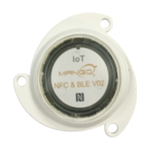RFID Journal News Roundup – February 20, 2020 – Tatwah Offers Ultra-Low-Power Bluetooth® 5 Beacons

Tatwah, an Internet of Things (IoT) solutions company, has announced a new generation of its Bluetooth® Low Energy beacons. The latest beacons are designed to enable systems integrators to monitor and track the activities of industrial assets, as well as analyze data and run AI algorithms on on-prem or cloud servers.
Tatwah’s MANGO-branded Bluetooth® beacons support iBeacon, Eddystone, AltBeacon and proprietary formats. They feature configuration options, operational parameters and an NFC tag interface that can be used to store information about an asset, maintenance data or localization. The beacons are designed with a modular approach for multi-sensor capabilities, security enhancements and customization, the company reports.
The devices are based on the RSL10 radio from ON Semiconductor, which provides ultra-low-power Bluetooth® connectivity, while helping to reduce overall system size and bill of materials (BoM). The RSL10 come with a suite of firmware, software and mobile app offerings.
The beacons have been deployed in various ecosystems, according to the company, and are supported by such IoT cloud platforms as AWS, Ayla and EVRYTHNG. They have been adopted by a range of systems integrators and end customers, and are intended to help companies connect their smart products via Bluetooth®, RFID, NFC and other RF connectivity options.
“With this new beacon family, Tatwah is instrumental in providing Bluetooth® Low Energy beacons leveraged end-to-end IoT solutions like asset tracking to clients,” said Egon Konopitzky, Tatwah’s senior executive VP, in a prepared statement. “Tatwah is extending its product offering to enable solutions in industries like predictive maintenance, smart building and cities, healthcare, wearable patches, people monitoring, inventory management, retail, logistics, etc., We will be extending our product portfolio with new and enriched devices all along 2020.”
Read the original RFID Journal annoucement
end of release
